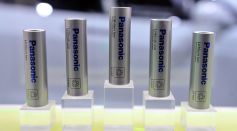NANOTECHNOLOGY
Biomolecular "Crown" Now Observable, Thanks to a Novel Method
Magic-Angle Twisted Graphene Could Play Host to New Phases of Matter
Nanomaterials Improve Hybrid Flow Battery Electrodes, Advancing Renewable Energy Storage
Researchers Engineer Nanoparticles To Create Super-Hard Metals
Too Small, Too Cool: NIST Scientists Miniaturize Laser Cooling

Mask Said To Deactivate Different Coronavirus Types in 2 Hours

Anode-Free Zinc-Based Battery Is the Future of Renewable Energy Storage
Scientists Establish Relationship Between Nanotube Length and Friction, To Guide Creation of Stronger Fibers
Researchers Set New Guinness World Record for Finest Woven Fabric

Ultra-Efficient, Nano-Thin Piezoelectric Materials Advance Self-Powered Electronics

Copper Cubes Used as Catalyst in New Reactor To Convert Carbon Monoxide Into Acetic Acid
Researchers Developed a “Swiss Army Knife” Catalyst from 10 Different Elements
New Femtosecond Laser Reported by Scientists
Quantum Entanglement of Electrons Achieved Through Heat
Most Popular

Will Earth's Magnetic Poles Flip Next? Magnetic Pole Reversal Explained Through Cutting‑Edge Magnetosphere Science

Relativity Time Dilation Explained: The Physics of Time and Why It Moves Differently in Space

How Lightning Science Reveals Why Charged Storms Are Rising with Global Warming Effects

How AI Is Used in Weather Prediction: Smarter Forecasting Through Machine Learning




